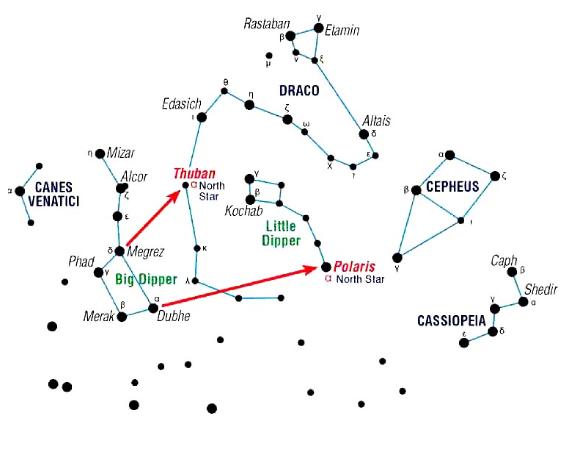 |
|
|
|
||
Thuban, the other North Star |
||
Article by Ken Graun |
||
Facts about Thuban Magnitude: +3.65. Some historical evidence suggests that Thuban may have been brighter in the past, maybe shining at magnitude 2.
Distance: 310 light years or 1,823 trillion miles, that is, 1,823,000,000,000,000 miles.
Mass: Thuban has 3.4 times more matter than our Sun.
Diameter: 5.7 times the diameter of our Sun, so it is considered a white giant star. Facts about Polaris In the sky, Polaris shines at about magnitude 2. It is about 433 light years away and has a diameter 30 times greater than our Sun. It is considered a giant star and has a mass of about 7.5 times that of our Sun. Brightness Comparison If the Sun, Polaris and Thuban were placed side by side, Polaris would be about 2,200 times brighter than our Sun with Thuban 300 times brighter than our Sun. |
||||
Very few stars as faint as Thuban are named (it shines at magnitude +3.7). So, why does this faint star in the constellation Draco, the Dragon, have a name? The reason might surprise you. Thuban means, “Whole of Draco” as well as, “Life of Heaven.” These very ancient meanings don’t give us much of a clue as to why this star has a name, unless you know the most important fact—Thuban was THE North Star 4,700 years ago. Back then, Thuban was located exactly where Polaris is located today. Thuban is no longer the North Star because the Earth wobbles on its axis which is now pointing toward Polaris. In about 20,000 years, the Earth’s axis will again point toward Thuban. So, the inconspicuous star Thuban was used as the North Star from about 3700 BC to 1900 BC. It was closest to the North Celestial Pole, that is, the spot in the sky that the Earth’s axis points to, at 2787 BC. Around 1900 BC, Kochab, in the bowl of the Little Dipper, took over as the North Star until Polaris became closer to the North Celestial Pole. Thuban is approximately in the middle of Draco, so this was the reason that its name has the meaning, “Whole of Draco,” because all of Draco circled around Thuban when it was the pole star. LOCATING THUBAN: As long as the sky is reasonably dark, Thuban is easy to find. The other two stars of the Big Dipper’s bowl point to Thuban—see chart below. |
||||
 |
||
What’s Out Tonight? is sponsored by Ken Press, publisher of astronomy books and charts. |
||